第八章 伦敦语言学流派
- 格式:ppt
- 大小:160.50 KB
- 文档页数:44

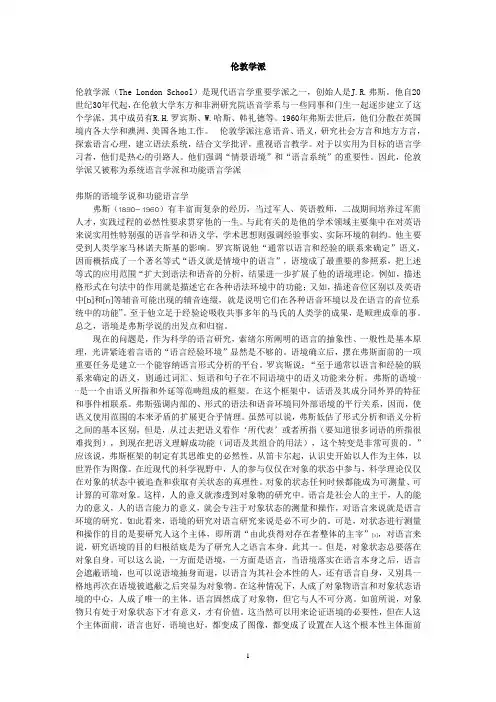
伦敦学派伦敦学派(The London School)是现代语言学重要学派之一,创始人是J.R.弗斯。
他自20世纪30年代起,在伦敦大学东方和非洲研究院语音学系与一些同事和门生一起逐步建立了这个学派,其中成员有R.H.罗宾斯、W.哈斯、韩礼德等。
1960年弗斯去世后,他们分散在英国境内各大学和澳洲、美国各地工作。
伦敦学派注意语音、语义,研究社会方言和地方方言,探索语言心理,建立语法系统,结合文学批评,重视语言教学。
对于以实用为目标的语言学习者,他们是热心的引路人。
他们强调“情景语境”和“语言系统”的重要性。
因此,伦敦学派又被称为系统语言学派和功能语言学派弗斯的语境学说和功能语言学弗斯(1890- 1960)有丰富而复杂的经历,当过军人、英语教师,二战期间培养过军需人才,实践过程的必然性要求贯穿他的一生。
与此有关的是他的学术领域主要集中在对英语来说实用性特别强的语音学和语义学,学术思想则强调经验事实、实际环境的制约。
他主要受到人类学家马林诺夫斯基的影响。
罗宾斯说他“通常以语言和经验的联系来确定”语义,因而概括成了一个著名等式“语义就是情境中的语言”,语境成了最重要的参照系,把上述等式的应用范围“扩大到语法和语音的分析,结果进一步扩展了他的语境理论。
例如,描述格形式在句法中的作用就是描述它在各种语法环境中的功能;又如,描述音位区别以及英语中[b]和[n]等辅音可能出现的辅音连缀,就是说明它们在各种语音环境以及在语言的音位系统中的功能”。
至于他立足于经验论吸收共事多年的马氏的人类学的成果,是顺理成章的事。
总之,语境是弗斯学说的出发点和归宿。
现在的问题是,作为科学的语言研究,索绪尔所阐明的语言的抽象性、一般性是基本原理,光讲紧连着言语的“语言经验环境”显然是不够的。
语境确立后,摆在弗斯面前的一项重要任务是建立一个能容纳语言形式分析的平台。
罗宾斯说:“至于通常以语言和经验的联系来确定的语义,则通过词汇、短语和句子在不同语境中的语义功能来分析。
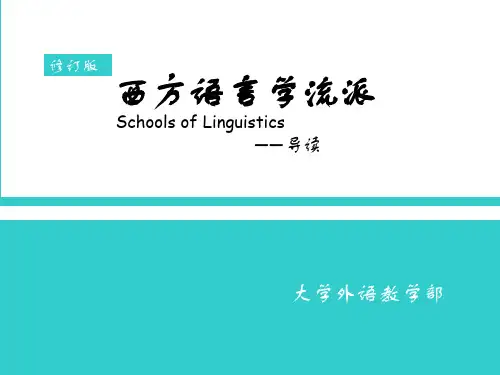

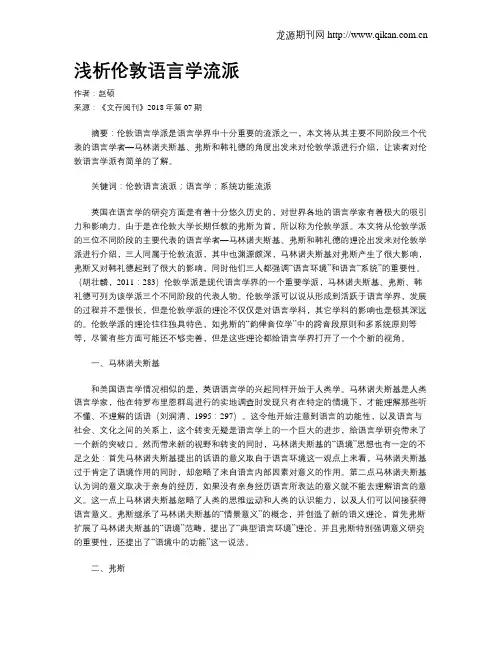
浅析伦敦语言学流派作者:赵硕来源:《文存阅刊》2018年第07期摘要:伦敦语言学派是语言学界中十分重要的流派之一,本文将从其主要不同阶段三个代表的语言学者—马林诺夫斯基、弗斯和韩礼德的角度出发来对伦敦学派进行介绍,让读者对伦敦语言学派有简单的了解。
关键词:伦敦语言流派;语言学;系统功能流派英国在语言学的研究方面是有着十分悠久历史的,对世界各地的语言学家有着极大的吸引力和影响力。
由于是在伦敦大学长期任教的弗斯为首,所以称为伦敦学派。
本文将从伦敦学派的三位不同阶段的主要代表的语言学者—马林诺夫斯基、弗斯和韩礼德的理论出发来对伦敦学派进行介绍,三人同属于伦敦流派,其中也渊源颇深,马林诺夫斯基对弗斯产生了很大影响,弗斯又对韩礼德起到了很大的影响,同时他们三人都强调“语言环境”和语言“系统”的重要性。
(胡壮麟,2011:283)伦敦学派是现代语言学界的一个重要学派,马林诺夫斯基、弗斯、韩礼德可列为该学派三个不同阶段的代表人物。
伦敦学派可以说从形成到活跃于语言学界,发展的过程并不是很长,但是伦敦学派的理论不仅仅是对语言学科,其它学科的影响也是极其深远的。
伦敦学派的理论往往独具特色,如弗斯的“韵律音位学”中的跨音段原则和多系统原则等等,尽管有些方面可能还不够完善,但是这些理论都给语言学界打开了一个个新的视角。
一、马林诺夫斯基和美国语言学情况相似的是,英语语言学的兴起同样开始于人类学。
马林诺夫斯基是人类语言学家,他在特罗布里恩群岛进行的实地调查时发现只有在特定的情境下,才能理解那些听不懂、不理解的话语(刘润清,1995:297)。
这令他开始注意到语言的功能性,以及语言与社会、文化之间的关系上,这个转变无疑是语言学上的一个巨大的进步,给语言学研究带来了一个新的突破口。
然而带来新的视野和转变的同时,马林诺夫斯基的“语境”思想也有一定的不足之处:首先马林诺夫斯基提出的话语的意义取自于语言环境这一观点上来看,马林诺夫斯基过于肯定了语境作用的同时,却忽略了来自语言内部因素对意义的作用。
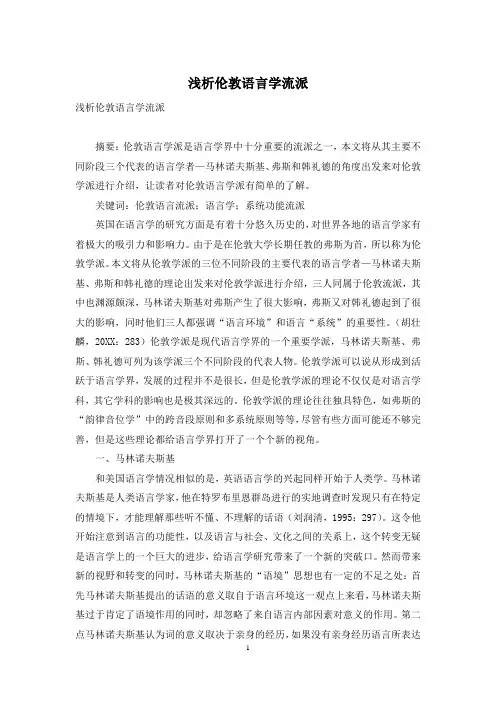
浅析伦敦语言学流派浅析伦敦语言学流派摘要:伦敦语言学派是语言学界中十分重要的流派之一,本文将从其主要不同阶段三个代表的语言学者—马林诺夫斯基、弗斯和韩礼德的角度出发来对伦敦学派进行介绍,让读者对伦敦语言学派有简单的了解。
关键词:伦敦语言流派;语言学;系统功能流派英国在语言学的研究方面是有着十分悠久历史的,对世界各地的语言学家有着极大的吸引力和影响力。
由于是在伦敦大学长期任教的弗斯为首,所以称为伦敦学派。
本文将从伦敦学派的三位不同阶段的主要代表的语言学者—马林诺夫斯基、弗斯和韩礼德的理论出发来对伦敦学派进行介绍,三人同属于伦敦流派,其中也渊源颇深,马林诺夫斯基对弗斯产生了很大影响,弗斯又对韩礼德起到了很大的影响,同时他们三人都强调“语言环境”和语言“系统”的重要性。
(胡壮麟,20XX:283)伦敦学派是现代语言学界的一个重要学派,马林诺夫斯基、弗斯、韩礼德可列为该学派三个不同阶段的代表人物。
伦敦学派可以说从形成到活跃于语言学界,发展的过程并不是很长,但是伦敦学派的理论不仅仅是对语言学科,其它学科的影响也是极其深远的。
伦敦学派的理论往往独具特色,如弗斯的“韵律音位学”中的跨音段原则和多系统原则等等,尽管有些方面可能还不够完善,但是这些理论都给语言学界打开了一个个新的视角。
一、马林诺夫斯基和美国语言学情况相似的是,英语语言学的兴起同样开始于人类学。
马林诺夫斯基是人类语言学家,他在特罗布里恩群岛进行的实地调查时发现只有在特定的情境下,才能理解那些听不懂、不理解的话语(刘润清,1995:297)。
这令他开始注意到语言的功能性,以及语言与社会、文化之间的关系上,这个转变无疑是语言学上的一个巨大的进步,给语言学研究带来了一个新的突破口。
然而带来新的视野和转变的同时,马林诺夫斯基的“语境”思想也有一定的不足之处:首先马林诺夫斯基提出的话语的意义取自于语言环境这一观点上来看,马林诺夫斯基过于肯定了语境作用的同时,却忽略了来自语言内部因素对意义的作用。
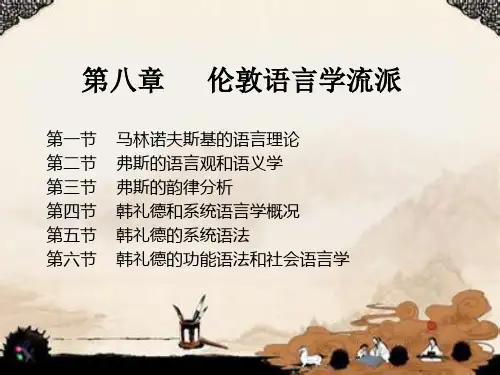
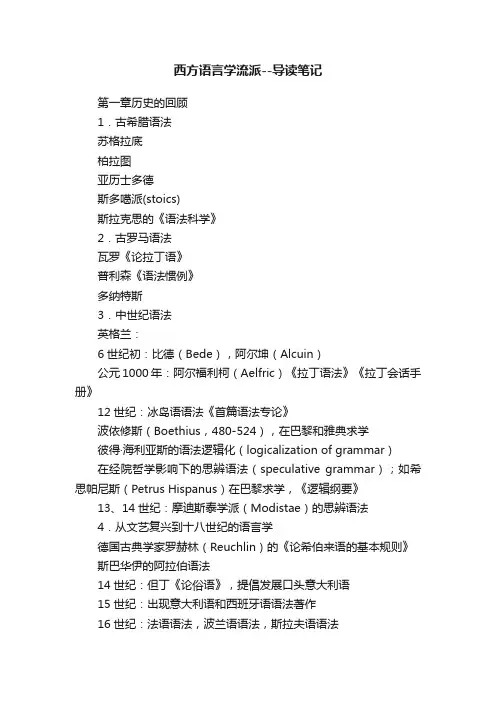
西方语言学流派--导读笔记第一章历史的回顾1.古希腊语法苏格拉底柏拉图亚历士多德斯多噶派(stoics)斯拉克思的《语法科学》2.古罗马语法瓦罗《论拉丁语》普利森《语法惯例》多纳特斯3.中世纪语法英格兰:6世纪初:比德(Bede),阿尔坤(Alcuin)公元1000年:阿尔福利柯(Aelfric)《拉丁语法》《拉丁会话手册》12世纪:冰岛语语法《首篇语法专论》波依修斯(Boethius,480-524),在巴黎和雅典求学彼得·海利亚斯的语法逻辑化(logicalization of grammar)在经院哲学影响下的思辨语法(speculative grammar);如希思帕尼斯(Petrus Hispanus)在巴黎求学,《逻辑纲要》13、14世纪:摩迪斯泰学派(Modistae)的思辨语法4.从文艺复兴到十八世纪的语言学德国古典学家罗赫林(Reuchlin)的《论希伯来语的基本规则》斯巴华伊的阿拉伯语法14世纪:但丁《论俗语》,提倡发展口头意大利语15世纪:出现意大利语和西班牙语语法著作16世纪:法语语法,波兰语语法,斯拉夫语语法法国哲学家拉梅(1515-1572):当时的结构主义先驱,反对亚里士多德和经院哲学,著有希腊语、拉丁语和法语等语法著作。
传教士活动使语言学家认识到世界语言的多样性和复杂性。
西班牙耶稣会传教士夏维尔等人第一次将汉语语法学传到欧洲。
经验主义学派:英国的布莱特创造速记方法和观察派语音学家霍尔德,理性主义学派:英国威尔金斯设想“哲学语言”,法国的保尔—罗瓦雅尔学派(思维是语言的基础)。
18世纪:法国哲学家康迪雅克的《论人类认识的起源》卢梭的《论人类不平等的起源和基础》德国哲学家海德(Herder1744-1803)《论语言的起源》1769英国讨论普遍语法:詹姆士?哈利斯《对语言和普遍语法的哲学探讨》(1751),霍恩?托柯,詹姆士?伯尼特。
5.古代印度的语言学梵语研究的发现开启了整个十九世纪的比较语言学和历史语言学。
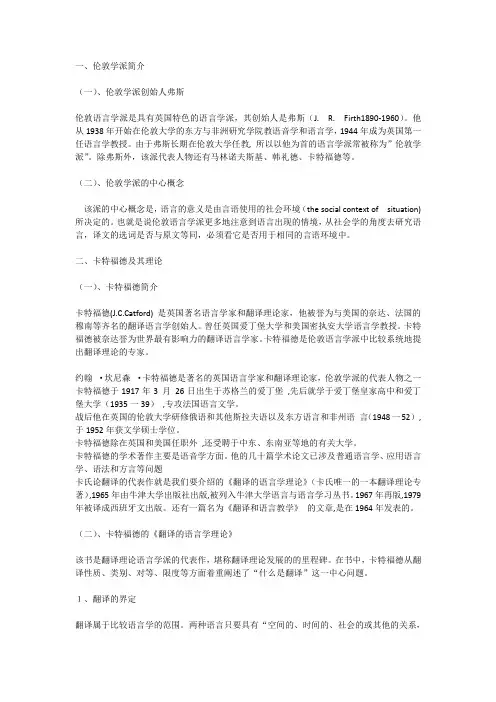
一、伦敦学派简介(一)、伦敦学派创始人弗斯伦敦语言学派是具有英国特色的语言学派,其创始人是弗斯(J.R.Firth1890-1960)。
他从1938年开始在伦敦大学的东方与非洲研究学院教语音学和语言学,1944年成为英国第一任语言学教授。
由于弗斯长期在伦敦大学任教, 所以以他为首的语言学派常被称为”伦敦学派”。
除弗斯外,该派代表人物还有马林诺夫斯基、韩礼德、卡特福德等。
(二)、伦敦学派的中心概念该派的中心概念是,语言的意义是由言语使用的社会环境(the social context of situation)所决定的。
也就是说伦敦语言学派更多地注意到语言出现的情境,从社会学的角度去研究语言,译文的选词是否与原文等同,必须看它是否用于相同的言语环境中。
二、卡特福德及其理论(一)、卡特福德简介卡特福德(J.C.Catford) 是英国著名语言学家和翻译理论家,他被誉为与美国的奈达、法国的穆南等齐名的翻译语言学创始人。
曾任英国爱丁堡大学和美国密执安大学语言学教授。
卡特福德被奈达誉为世界最有影响力的翻译语言学家。
卡特福德是伦敦语言学派中比较系统地提出翻译理论的专家。
约翰·坎尼森·卡特福德是著名的英国语言学家和翻译理论家,伦敦学派的代表人物之一卡特福德于1917年3 月26日出生于苏格兰的爱丁堡,先后就学于爱丁堡皇家高中和爱丁堡大学(1935一39),专攻法国语言文学。
战后他在英国的伦敦大学研修俄语和其他斯拉夫语以及东方语言和非州语言(1948一52),于1952年获文学硕士学位。
卡特福德除在英国和美国任职外,还受聘于中东、东南亚等地的有关大学。
卡特福德的学术著作主要是语音学方面。
他的几十篇学术论文已涉及普通语言学、应用语言学、语法和方言等问题卡氏论翻译的代表作就是我们要介绍的《翻译的语言学理论》(卡氏唯一的一本翻译理论专著),1965年由牛津大学出版社出版,被列入牛津大学语言与语言学习丛书。

《语⾔教学的流派》笔记(最新整理)第三章The oral approach and situational language teachingThe oral approach (situational language teaching) is a grammar-based method inwhich principles of grammatical and lexical gradation are used and new teachingpoints are presented and practiced through meaningful situation-based activities.⼀、Background1. Two of the leaders were Harold palmer and A.S.Hornby.2. Vocabulary control3. Grammar control⼆、The Oral Approach and Situational Language TeachingThe main characteristics of the approach were as follows:1. Language teaching begins with the spoken language. Material is taught orally.2. The target language is the language of the classroom.3. New language points are introduced and practiced situationally.4. Vocabulary selection procedures are followed to ensure that an essential general service vocabulary is covered.5. Items of grammar are graded by their complexity.6. Reading and writing are introduced once a sufficient lexical and grammatical basis is established.三、Approach1、Theory of languagea type of British “structuralism”.○1One distinctive feature: structures must be linked to situations in which they could be used○2Language was viewed as purposeful activity related to goals and situations in the real world.○32、Theory of learninga type of behaviorist habit-learning theory(three processes in learning a language)(1). Language learning as habit formation(2).An inductive approach is used to the teaching of grammar(3).The same processed are thought to occur both in child language learning and in second language learning.四、Design1、Objectives:(1). Practical command of the four basic skills of language(2). Accuracy in both pronunciation and grammar is regarded as crucial.(3). Automatic control of basic structures and sentence patterns is fundamental.(4). Writing derives from speech.2、The syllabus(1) A structural syllabus—a list of the basic structures and sentence patterns(2) Situation: the manner of presenting and practicing sentence patterns3、Types of learning and teaching activities(1) SLT employs a situational approach to presenting new sentence patterns and a drill-based manner to practicing the new sentence patterns(2) Situation: the use of concrete objects, pictures and realia, which together with actions and gestures(3) Practice techniques: guided repetition, substitution activities, pair practice4、Learner roles(1) Listen, repeat and responds to questions and commands(2) Have no control over the content of learning5、Teacher rolesThreefold: a model、a skillful manipulator、on the lookout for errorsThe teacher is essential to the success of the method.6、The role of instructional materials(1)Textbook: contains organized lessons(2)Visual aids: consists of wall charts, flashcards, pictures, stick figuresThe teacher is expected to be the master of his textbook.五、ProcedureAim: to move from controlled to freer practice of structures and from oral use of sentence patterns to their automatic use in speech, reading and writing.The teaching of a structure: four partsPronunciationRevision ( to prepare for new work if necessary)Presentation of new structure or vocabularyOral practice (drilling)Reading of material on the new structure, or written exercisesThe sequence of activities:Listening practiceChoral imitationIndividual imitationIsolationBuilding up to a new modelElicitationSubstitution drillingQuestion-answer drillingCorrection第四章The Audiolingual MethodIt is a method of foreign or second language teaching which (a) emphasizes theteaching of speaking and listening before reading and writing (b) uses dialoguesand drills. (c) discourages use of the mother tongue in the classroom (d) oftenmakes use of contrastive analysis. The audiolingual method was prominent inthe 1950s and 1960s, especially in the United States, and has been widely used inmany other parts of the world.⼀、BackgroundThe combination of structural linguistic theory, contrastive analysis, aural-oral procedures, and behaviorist psychology led to the Audiolingual Method.⼆、Approach1、Theory of languageStructural linguistics (1950s): a reaction to traditional grammarThe primary medium of language is oral: speech is language.2、Theory of learningBehavioral psychology: stimulus-response chainsLearning principles:1. Foreign language learning is basically a process of mechanical habit formation.2. Language skills are learned more effectively if the items to be learned in the target language are presented in sporken form before they are seen in written form.3. Analogy provides a better foundation for language learning than analysis. Hence the approach to the teaching of grammar is essentially inductive rather than deductive.4.The meaning of word can be learned in a linguistic and cultural context and not in isolation.三、Design1、ObjectivesShort-range objectives:Listening comprehension、accurate pronunciation, reading comprehension and production of correct sentences in writing.Long-range objectives :To develop in the students the same types of abilities that native speakers have2、The syllabusA linguistic syllabus: phonology, morphology, and syntax of the languageA lexical syllabus of basic vocabularyLanguage skills: listening, speaking, reading, writing3、Types of learning and teaching activitiesDialoguesDrills --Various kinds of drills : repetition, inflection, replacement…4、Learner rolesOrganisms that can be directed by skilled training techniques to produce correct responsesa reactive role, have little control5、Teachers rolesCentral and activeModels the target languageControls the direction and pace of learningMonitors and corrects the learners’ performance6、The role of instructional materialsTextbookTape recorders and audiovisual equipment四、Procedure1、The process of teaching involves extensive oral instruction2、The procedures the teacher should adopt ( Brook)3、In a typical audiolingual lesson the following procedures will be observed:a. Recognition;b. Imitation and repetitionc. Patterns drill:d. Follow-up activities五、The decline of Audiolingualism1、Criticism on two fronts: the theoretical foundations(both in language and language learning)and the practical results fell short of expectation.2、the theoretical attack: Noam Chomsky’s theory of transformational grammar情境法与听说法的异同There are many similarities between situational language teaching and audiolingualism.1. The order in which language skills are introduced2. Focus on accuracy through drill and practice in the basic structures3. Sectence patterns of the target languageHowever, situational language teaching was a development of the earlier Direct Method and does not have the strong ties to linguistic and behavioral psychology that characterize audiolingualism. The similarities of the two methods reflect similar views about the nature of language and of language learning, through these views were in fact development from quite different traditions.第五章Communicative Language Teaching⼜称:功能—意念法(The Functional-Notional Approach )The CLT is an approach to foreign or second language teaching which emphasizesthat the goal of language learning is communicative competence. Teachingmaterials used with the Communicative approach often teach the language neededto express and understand different kinds of functions. The approach follows aNational syllabus and emphasizes the processes of communication to getinformation, and using language for social interaction with other people.⼀、BackgroundThe origins of the CLT are to be found in the changes in the British language teaching tradition dating from the late 1960s.In the late sixties, the current SLT was questioned.British applied linguistics began to emphasize the fundamental dimension of language teaching at that time- the functional and communicative potential of language. Scholars argued for focus in language teaching on communicative proficiency rather than on mere mastery of structures.⼆、Approachlanguage as communication三、Design1、ObjectivesPiepho’s discussion (general objectives)1.an integrative and content level(language as a means of expression)2.an linguistic and instrumental level(language as a semiotic system and an object of learning)3.an affective level of interpersonal relationships and conduct(language as a means of expressing values and judgments about oneself and others.)4.a level of individual learning needs(remedial learning based on error analysis)5.a general educational level of extra-linguistic goals(language learning within the school curriculum) No defined particular objectives2、The syllabusNotional syllabus which specified the semantic-grammatical categories and the categories of communicative function that learners need to express.3、Types of learning and teaching activitiesClassroom activities are unlimited.Littlewood (functional communication activities and social interaction activities)1. Functional communication activities: ones aimed at developing certain languageskills and functions, but which involve communication, and2. Social interaction activities, such as conversation and discussion sessions, dialoguesand role plays4、Learner roles①a negotiator②a communicator③a contributor④an independent learner5、Teacher roles①a facilitator of the communication②an independent participant within the learning-teaching group③Need analyst (formally and informally)④Counselor⑤Group process manager6、The role of instructional materialsText-based materialsTask-based materialsRealia 实物教具四、ProcedureDescription of typical classroom procedures used in a lesson based on CLT principles is not feasible.Conclusion:Communicative Language Teaching is best considered an approach rather than a method. It appeared at a time when British language was ready for a paradigm shift. CLT appealed to those who sought a more humanistic approach to teaching, one in which the interactive processes of communication received priority. Now that the initial wave of enthusiasm has passed, some of the claims of CLT are being looked at more critically.第六章Total Physical ResponseTotal Physical Response is a language learning method based on the coordinationof speech and action. This method of learning was developed by James Asher, aprofessor of psychology at San Jose State University, California.⼀、Background1、the “trace theory” of memory in psychology2、developmental psychology:child first language acquisition3、humanistic psychology: the role of affective factors4、Comprehension Approach5、a tradition: the use of physical actions to teach a foreign language at an introductory level⼆、Approach1、Theory of languagestructuralist or grammar-based views of languagedetailed cognitive map (abstractions and nonabstractions)the central role of comprehension in language learninglanguage can be internalized as wholes or chunks2、Theory of learningReminiscent of the views of behavioral psychology: a stimulus-response viewLearning hypotheses ( to facilitate or inhibit foreign language learning ) According to Asher, the language learning theories are similar to those of other behavioral psychologists. The principals that help elaborate his idea are:1. Second language learning is parallel to first language learning and should reflect the same naturalistic processes.2. Listening should develop before speaking.3. Once listening comprehension has been developed, speech develops naturally and effortlessly out of it.4. Adults should use right-brain motor activities, while the left hemisphere watches and learns.三、Design1、ObjectivesThe general objectives: to teach oral proficiency at a beginning levelSpecific instructional objectives are not elaborated.2、The syllabus:Be inferred from an analysis of the exercise types employed in TPR classesA sentence-based syllabusA fixed number of items be introduced at a timeAttention to both the global meaning of language and the finer details of its organization3、Types of learning and teaching activitiesImperative drills are the major classroom activity.Role plays:center on everyday situationSlide presentationsReading and writing activities4、Learner rolesA primary role : listener and performerHave little influence over the contentMonitor and evaluate their own progress5、Teacher rolesActive and direct roleWell prepared and well organizedTeachers follow the example of parents giving feedbackCautions: illusion of simplicity; having too narrow a tolerance for errors6、The role of instructional materialsNo basic text, materials and realia play an increasing role in later learning stages. Student kits that focus on specific situations (supporting materials)四、ProcedureAsher’s account of a course:ReviewNew commandsRole reversalReading and writingConclusion:Total Physical Response has enjoyed some popularity because of its support by thosewho emphasize the role of comprehension in second language acquisition.It represents a useful techniques and is compatible with other approaches to teaching.4.Traits 1. It uses psychomotor systems to teach.2. It support kinesthetic learning style, which is good for those who need to be active in the class.3. Command forms used to convey information.4. It works well with mixed-ability classes.5. It is very memorable, and it really helps students to remember phrases or words.6. It is a lot of fun, students enjoy it and it can be a real stirrer in the class.7. It is very effective with teenagers and young learners.第七章The Silent WayIt is a method of foreign-language teaching developed by Gattegno which makesuse of gesture, mime, visual aids, wall charts, and in particular Cuisiniere rods(wooden sticks of different lengths and colors) that the teacher uses to help thestudents to talk. The method takes its name from the relative silence of the teacherusing these techniques.⼀、BackgroundThe premise of the Silent WayThe learning hypothesesLearning is facilitated if the learner discovers or creates. (discovery learning)Learning is facilitated by accompanying physical objects.Learning is facilitated by problem solving.⼆、Approach1、Theory of languageGattegno views language as a substitute for experience.By the "spirit" of the language Gattegno is referring to the way each language isComposed of phonological and suprasegmentalA structural approachVocabulary as a central dimension2、Theory of learningSurrenderArtificial approachThe self of the learnerLearning to learn三、Design1、ObjectivesThe general objectives: to give beginning level students oral and aural facilityAn immediate objectives: to provide the learner with a basic practical knowledge of the grammar of the language Teach learners how to learn a language2、The syllabusa basically structural syllabusvocabulary3、Types of learning and teaching activitiessimple linguistic tasksresponses to commands, questions and visual cues4、Learner rolesLearners are expected to develop independence, autonomy and responsibility.Learners exert a strong influence over each other’s learning.Playing varying roles5、Teacher rolesTeacher silence is the most demanding aspect of the Silent Way.To teach, to test, to get out of the wayCreate an environmentTeacher likes the complete dramatist.6、The role of instructional materialsThe pronunciation chartsThe colored cuisenaire rodsThe vocabulary or word chartsOther materials四、ProcedureA standard formatPractice of the sounds (using the pronunciation charts)Practice of sentence patterns, structure, and vocabulary (using the rods and charts)A sample lessonConclusion:The actual practices of the Silent Way are much less revolutionary than might be expected. The innovations derive from the manner in which classroom activities are organized, the indirect role the teacher is required to assume in directing and monitoring learner performance, the responsibility placed upon learners, and the materials used.第⼋章Community Language LearningIt is a method of second and foreign language teaching developed by Charles Curran. CLL is an application of counseling learning(咨询学习法)to second andforeign language teaching and learning. It uses techniques developed in groupcounseling to help people with psychological and emotional problems. The methodmakes use of group learning in small or large groups. These groups are the“Community”. The method places emphasis on the learners’ personal feelings andtheir reactions to language learning. Learners say things which they want to talkabout, in their native language. The teacher (known as “Counselor”) translatesthe learners’ sentences into the foreign language, and the learner then repeats thisto other members of the group.⼀、Background1、Rogerian counseling2、Humanistic techniques:the whole person3、Language alternation⼆、Approach1、Theory of languageTraditional structuralist positionLanguage as social processThe interactional view of language: interaction between equals, interaction between unequals2、Theory of learningContracted with traditional views (a putative learning view, the behavioral view)The whole-person learning (five stages)Consensual validationS(secure)A(attention and aggression)R(retention and reflection)D(discrimination)the personal commitments三、Design1、ObjectivesExplicit linguistic or communicative objectives are not defined.Teacher transfers knowledge and proficiency to the learner.Goal: attaining near-native like mastery of the target languageSpecific objectives are not addressed.2、The syllabusNo conventional language syllabusTopic-based courseTeacher’s responsibility3、Types of learning and teaching activitiesCombines innovative learning tasks and activities with conventional ones.Translation, Group Work, Recording, Transcription, Analysis, Reflection and observation, Listening, Free conversation4、Learner rolesmembers of a communitybecome counselors to other learnersFive stages5、Teacher rolesCounselorSpecific teacher roles are keyed to the five development stages.providing a safe environmentNote two “asides” in the discussion of learning security.6、The role of instructional materialsA textbook is not considered a necessary component.Materials may be developed by the teacher as the course develops.the use of teaching machines四、Procedure1、 classical CLL and personal interpretations of it2、 the description of some typical activities in CLL classed3、 a protocol of what a first day’s CLL class coveredConclusion:Community Language Learning is the most responsive of the methods we have reviewed in terms of its sensitivity to learner communication intent. It places unusual demands on language teachers. Critics of Community Language Learning question many aspects of CLL. Supporters of CLL emphasize the positive benefits of a method that centered on the learner and stresses the humanistic side of language learning.Question for discussion:社团学习法把语⾔学习过程⽐作是咨询过程,你们觉得这个⽐喻合适吗?为什么?第九章The Natural ApproachIt is a term for an approach proposed by Terrell, to develop teaching principleswhich(a) emphasize natural communication rather than formal grammar study(b) are tolerant of learners’ errors(c) emphasize the informal acquisition of language rules.⼀、Background1、Tracy Terrell and Stephen Krashen2、The Natural Approach and traditional approaches3、The Natural Approach and the Natural Method⼆、Approach1、Theory of languagecommunication as the primary function of languagegive little attention to a theory of languageThe importance of vocabulary is stressed.view language learning as mastery of structures by stages (I+1)a view of language consists of lexical items, structure, and messages2 Theory of learning: Krashen’s language acquisition theoryThe Acquisition/Learning hypothesisThe monitor hypothesisThe natural order hypothesisThe input hypothesisThe affective filter hypothesis三、Design1、ObjectivesExpectationSpecific objectives depend upon learner needs and the skill and level being taught.It is important to communicate to learners what they can expect of a course as well as what they should not expect.2、The syllabusTwo points of view to approach course organizationContent selection3、Types of learning and teaching activitiesCommand-based activitiesDirect Method activitiesSituation-based practice of structures and patternsGroup-work activitiesthe characteristics of the Natural Approach4、Learner rolesa processor of comprehensible inputLearners’ roles change according to their stages of linguistic development.Learner have four kinds of responsibilities.5、Teacher rolesThree central rolesa. the primary source of comprehensible inputb. create a classroom atmospherec. choose and orchestrate a rich mix of classroom activities6、The role of instructional materialsthe primary goal of materialsthe primary aim of materialsother recommended materialsgames四、ProcedureThe Natural Approach adopts techniques and activities freely from various method sources.ExamplesConclusion:The Natural Approach belongs to a tradition of language teaching methods based on observation and interpretation of how learners acquire both first and second languages in nonformal setting. Its greatest claim to originality lies not in the techniques it employs but in their use in a method that emphasizes comprehensible and meaningful practice activities, rather than production of grammatically perfect utterances and sentences.Question for discussion:⾃然法的⾃然之处在哪⾥?创新之处⼜在哪⾥?第⼗章SuggostopediaSuggestopedia/Lozanov Method (暗⽰法/罗扎诺夫法)It is a method of foreign-language teaching developed by the Bulgarian Lozanov. It makes use of dialogues, situations and translation to present andpractise language, and in particular, makes use of music, visual images, andrelaxation exercises to make learning more comfortable and effective.⼀、Background1、Suggestology2、the most conspicuous characteristics of Suggestopedia3、Soviet psychology4、mental states5、the centrality of music and musical rhythm to learning⼆、Approach1、Theory of languagelexis is centralwhole meaningful texta language to be its vocabulary and the grammar rules for organizing vocabulary2、Theory of learninga desuggestive-suggestive sensesix principal theoretical components:authority, infantilization, double-planedness, intonation, rhythm, concertpseudo-passivenessthe type of musicthe rate of presentation of material to be learned within the rhythmic pattern三、Design1、Objectivesdeliver advanced conversational proficiency quicklyincreased access to understanding and creative solutions of problems2、The syllabuscourse descriptiontime durationeach unitthe whole course3、Types of learning and teaching activitiesimitation, question and answer, role playlistening activities4Learner rolesThe mental state of the learner is critical to success. mind-alteringinfantilization5、Teacher rolesthe primary role of the teacherexpected teacher behaviorsneeds three to six months training in acting, singing, and psychotherapeutic techniques6 The role of instructional materialsDirect support materials: text and tapeIndirect support materials: classroom fixtures and music四、ProcedureBancroft’s description: a four-hour language class has three distinct parts.The first part: an oral review sectionThe second part: new material is presented and discussedThe third part: the séance or concert sessionConclusion:Suggestopedia has probably received both the most enthusiastic and the most critical response of any of the so-called new methods. It is not productive to further belabor the science/nonscience, date/double-talk issues and instead try to identify andvalidate those techniques from Suggestopedia that appear effective and that harmonize with other successful techniques in the language teaching inventory.Question for discussion;暗⽰法强调⾳乐的作⽤,那么⾳乐在外语学习过程中究竟起了怎样的作⽤?谈谈你们的看法。
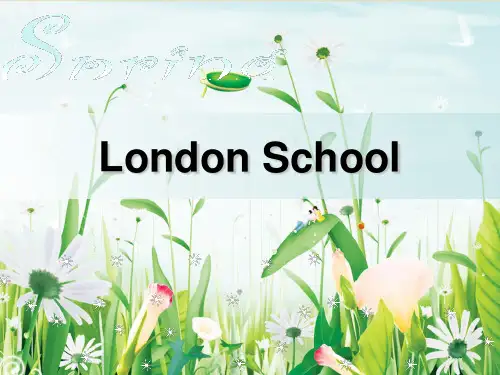
伦敦学派语言学伦敦学派是现代语言学的重要流派之一,它在语言学的发展历程中有着独特的地位和深远的影响。
伦敦学派起源于 20 世纪 30 年代末至 40 年代初的英国伦敦,这一时期的社会背景和学术氛围为其产生和发展提供了土壤。
当时,英国正经历着社会和文化的变革,对于语言的研究也逐渐从传统的语法和修辞转向了更注重语言的实际使用和功能。
伦敦学派的代表人物主要有弗斯、韩礼德等。
弗斯被认为是伦敦学派的先驱,他强调语言环境的重要性,认为语言是一种社会现象,不能脱离其使用的环境来研究。
他提出了“情景语境”的概念,认为语言的意义取决于其所处的具体情景。
这一观点打破了传统语言学只关注语言内部结构的局限,将语言与社会、文化等外部因素紧密结合起来。
韩礼德则是伦敦学派的集大成者,他在弗斯的基础上发展了系统功能语言学。
韩礼德认为语言具有三大元功能,即概念功能、人际功能和语篇功能。
概念功能指语言用于表达人们对世界的经验和认知;人际功能用于建立和维持人与人之间的关系,表达态度、情感等;语篇功能则是使语言成为一个连贯的整体。
伦敦学派语言学的特点之一是强调语言的系统性。
它认为语言不是孤立的元素的集合,而是一个相互关联、相互制约的系统。
在这个系统中,各个成分按照一定的规则和模式组合在一起,共同实现语言的功能。
另一个特点是注重语言的功能研究。
伦敦学派认为语言的形式是由其功能决定的,而不是相反。
例如,在不同的语境中,人们会使用不同的语言形式来实现不同的交际目的。
伦敦学派语言学在语言教学方面也有着重要的应用价值。
它强调语言的实际运用,注重培养学生在具体语境中正确、得体地使用语言的能力。
这与传统的以语法和词汇为中心的教学方法有所不同,更符合语言学习的本质规律。
在翻译研究领域,伦敦学派的理论也为翻译实践提供了有益的指导。
翻译不仅仅是语言形式的转换,更要考虑到语言的功能和语境。
例如,在翻译过程中,要根据目标语的语境和功能要求,对原文进行适当的调整和改写,以确保译文能够准确传达原文的意义,并在目标语中发挥相应的功能。
语言学发展简史伦敦语言学派一、伦敦语言学派的渊源:英国早期的语言研究成就主要在语音方面。
到十九世纪末期,出现一位非常有名的语音学家享利·斯威特(Henry Sweet,1845—1912),他于1877年出版了《语音学手册》,这本书奠定了现代语音学这门学科的基础。
另一位著名的语音学家丹泥尔·琼斯(Daniel Jones,1881—1967)继承了斯威特的传统,在英语语音规范上作出了很大贡献,并在英国大学里建立了第一个语音学系。
(美式英语标音标准k.k——Kenyon & Knott)二、伦敦语言学派简介:(一)John Rupert Firth,1890—1960)——弗斯大学学的是历史,年轻时投笔从戎,在一战斯间到过印度、阿富汗和非洲等地服兵役,先后在印度拉合尔旁遮普大学教学,回国后又在伦敦大学任教,并结识了著名人类学语言学家马林诺夫斯基,两人成为亲密的朋友。
之后于1837年又回印一年,调查研究古吉拉特语(Gujarati)和泰卢固语(Telugu),1838年返回英国后一直固定在伦敦大学东方与非洲研究学院任教,并研究语音学和语言学。
1944年成为英国第一任语言学教授。
弗斯的学生中有相当多后来都成为著名的语言学家,如韩里德(M.A.K.Halliday)、麦金托什(Angus Mclntosh)、史蒂文斯(Peter Stevens)、阿伦(W.S.Allen)、罗宾斯(R.H.Robins)、莱昂斯(J.Lyons)等。
1、语言除了具有语言内部上下文,还具有情境上下文。
这一观点是受到马林诺夫斯基的影响。
马林诺夫斯基曾经到巴布亚新几内亚的特罗布里恩德群岛做人类学研究,他发现当地土著语言很难译成英语。
例如,划独木船的人把独木船的桨叫做“wood”(木头),如果不把这个人的话与当时的环境结合在一起理解,就不能理解“wood”指的是什么。
因此他说:“话语与环境互相紧密地纠结在一起,语言的环境对于理解语言是必不可少的。
伦敦语言学派综述摘要伦敦学派是语言学发展史上的一个重要流派,该学派在英国备受推崇。
伦敦学派主张从社会的角度研究语言,注意语言的意义、工具性质和语言使用的情景,在伦敦学派的基础上发展起来的系统功能语法也认为意义和功能是人类语言和交际活动的基础。
对伦敦语言学派的研究成果进行一番系统梳理,有助于更好的掌握了解该学派在语言学理论所作出的贡献,以及对语言学发展产生的影响和作用。
关键词:伦敦语言学派,语境理论,重要贡献,语言学一、历史背景20世纪30年代以后的语言学都受到索绪尔的影响,把语言当做一个完整的系统去研究。
但由于切入点与侧重点不同,各派的基本理论亦有所不同。
如欧洲的几个语言学派更多地注意到语言的功能和符号性,美国的结构主义更注意形式分析和客观描写;转换生成语法则从心理学的角度去研究语言;而英国的语言学家则更多地注意到语言出现的情景,从社会学的角度去研究语言.英国有研究语言学的悠久传统, 特别是语音学。
早在15、16 世纪文艺复兴之前, 欧洲大陆还普遍使用古拉丁语,而拉丁语以外的语言如英语等民族语言被嘲笑为俗语时,英语研究已在英国本土引起了人们的浓厚兴趣.正音学、词典学等合乎规范化要求的学问首先发展起来。
19 世纪末,英国出现了像亨利·斯威特那样的语音学家,他的《语音学手册》被誉为“教会了欧洲人语音学,使英国成了语音学这门现代科学的发源地” 。
久负盛名的丹尼尔·琼斯继承了斯威特的工作,成了英语语音学和普通语音学的先驱.英国理论语言学的创始人是与琼斯同时代的约翰·鲁珀特·弗斯,因弗斯长期在伦敦大学任教,故以他为首的语言学派被称作“伦敦语言学派” .他培养的学生中最著名者有韩礼德、罗宾斯、莱昂斯等.二、伦敦语言学派及具体理论“伦敦学派是当今语言学界的一个重要学派,与美国的结构主义派和转换语法派、捷克的布拉格学派、丹麦的哥本哈根学派同样为人注目”。
伦敦学派(The London School)又称弗斯语言学(Firthian Linguistics).从20世纪40年代到60年代,弗斯是英国语言学界的中心人物.弗斯从1938年就开始在伦敦大学东方及非洲研究学院教授语音学和语言学,在伦敦大学长期的教学与研究工作中,弗斯的语言学理论逐渐成熟,同时伦敦大学也成为传播其语言学理论的最好平台.因此,以他为首的英国语言学派被称为“伦敦学派”。
一、伦敦学派简介(一)、伦敦学派创始人弗斯伦敦语言学派是具有英国特色的语言学派,其创始人是弗斯(J.R.Firth1890-1960)。
他从1938年开始在伦敦大学的东方与非洲研究学院教语音学和语言学,1944年成为英国第一任语言学教授。
由于弗斯长期在伦敦大学任教,所以以他为首的语言学派常被称为”伦敦学派”。
除弗斯外,该派代表人物还有马林诺夫斯基、韩礼德、卡特福德等。
(二)、伦敦学派的中心概念该派的中心概念是,语言的意义是由言语使用的社会环境(the social context of situation)所决定的。
也就是说伦敦语言学派更多地注意到语言出现的情境,从社会学的角度去研究语言,译文的选词是否与原文等同,必须看它是否用于相同的言语环境中。
二、卡特福德及其理论(一)、卡特福德简介卡特福德(J.C.Catford) 是英国著名语言学家和翻译理论家,他被誉为与美国的奈达、法国的穆南等齐名的翻译语言学创始人。
曾任英国爱丁堡大学和美国密执安大学语言学教授。
卡特福德被奈达誉为世界最有影响力的翻译语言学家。
卡特福德是伦敦语言学派中比较系统地提出翻译理论的专家。
(二)、卡特福德的《翻译的语言学理论》该书是翻译理论语言学派的代表作,堪称翻译理论发展的的里程碑。
在书中,卡特福德从翻译性质、类别、对等、限度等方面着重阐述了“什么是翻译”这一中心问题。
1、翻译的界定翻译属于比较语言学的范围。
两种语言只要具有“空间的、时间的、社会的或其他的关系,都可以建立翻译等值关系。
这就是说,翻译不仅包括不同语种之间的转换,同时还包括不同方言变体、同种语言不同时期语言变体、不同社会阶层语言变体、不同行业或专业语言变体之间的转换。
卡特福德认为,翻译是“用一种等值的语言(译语)的文本材料(textual material)去替换另一种语言(原语)的文本材料”。
2、翻译的分类卡特福德从翻译的程度(extent)、层次(levels)、和等级(ranks)三个方面将翻译进行如下分类:(1)、就其程度而论,翻译可分为全文翻译(full translation)和部分翻译(partial translation)。